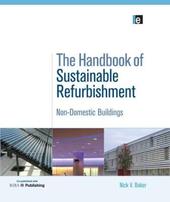
|
The Handbook of Sustainable Refurbishment: Non-domestic Buildings
Hardback
Main Details
| Title |
The Handbook of Sustainable Refurbishment: Non-domestic Buildings
|
| Authors and Contributors |
By (author) Nick Baker
|
| Physical Properties |
| Format:Hardback | | Pages:184 | | Dimensions(mm): Height 246,Width 189 |
|
| Category/Genre | Public buildings - civic, commercial, industrial, etc
Building construction and materials |
|---|
| ISBN/Barcode |
9781844074860
|
| Classifications | Dewey:690.24 |
|---|
| Audience | | Undergraduate | | Postgraduate, Research & Scholarly | | Professional & Vocational | |
|---|
| Illustrations |
Photographs, figures, diagrams, tables
|
|
Publishing Details |
| Publisher |
Taylor & Francis Ltd
|
| Imprint |
Earthscan Ltd
|
| Publication Date |
24 August 2009 |
| Publication Country |
United Kingdom
|
Description
The refurbishment of existing buildings is a crucial yet often neglected subject within sustainable architecture; attention is usually focused on new buildings. Many old buildings waste large amounts of energy and provide poor internal conditions for occupants through poor lighting, poor ventilation, solar penetration and glare, and poor control of heating and cooling. Demolition is an option but the refurbishment alternative is increasingly seen as more sustainable in terms of architectural value, materials use, neighbourhood disruption and waste disposal. In addition, the potential impact of low energy refurbishment is much greater than that for new build since there are many more buildings already in existence than will be built in the next 10 - 20 years, the period over which many CO2emission targets apply. The Handbook of Sustainable Refurbishment: Non-Domestic Buildings offers architects, engineers and a wide range of building professionals practical advice, illustrated by real examples. It moves from principles of sustainable refurbishment to specific design and engineering guidance for a variety of circumstances. It emphasises the need for an integrated approach by showing how refurbishment measures interact with one and other, and with the occupants, and how performance is ultimately influenced by this interaction.
Author Biography
Nick V. Baker is an independent consultant and technical expert on energy efficient refurbishment and the development of LT software. He is affiliated to The Martin Centre, Department of Architecture, University of Cambridge.
Reviews'An incisive book that provides practical strategies and tactics for sustainable refurbishment, literally from the ground up. Richly illustrated with informative diagrams, supported by accessible quantitative analysis, and reinforced by detailed case study examples, this book is a triumph.' Koen Steemers PhD RIBA/ARB, Professor of Sustainable Design and Head of the Department of Architecture, University of Cambridge 'Nick Baker tackles head on what many eminent scientists in Cambridge regard as most pressing contemporary problems, the sustainable refurbishment of the existing building stock, much of which is going to be with us still in 2050. Dr. Baker delivers his profound understanding of these difficult issues in a wholly intelligible and compelling way. I cannot commend this book to my profession and its patrons highly enough.' Professor Alan Short, University of Cambridge and Short and Associates Architects 'Definitely worth reading, learning from and implementing the practical experience of the REVIVAL team.' Building Engineer Magazine 'Innovative ideas for improvements, which may become increasingly necessary in the coming years ... a challenging and interesting read, providing complex technical solutions to issues which require a full understanding of building pathology.' Context Journal, Institute of Historic Building Conservation 'Challenging and interesting read.' Context, IHBC 'The Hanbook of Sustainable Refurbishment offers practical advice illustrated by real examples'. DETAIL Magazine 'A very useful introduction to the subject ... appropriate for younger professionals and also for their more experienced colleagues who may be contemplating undertaking sustainable refurbishment for the first time.' Proceedings of the Institute of Civil Engineers
|